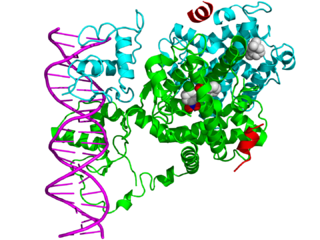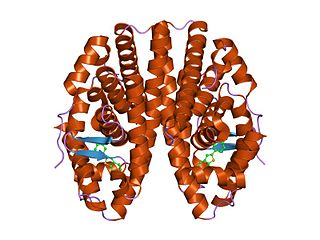Related Research Articles

The bile acid receptor (BAR), also known as farnesoid X receptor (FXR) or NR1H4, is a nuclear receptor that is encoded by the NR1H4 gene in humans.

In the field of molecular biology, nuclear receptors are a class of proteins responsible for sensing steroids, thyroid hormones, vitamins, and certain other molecules. These intracellular receptors work with other proteins to regulate the expression of specific genes thereby controlling the development, homeostasis, and metabolism of the organism.

The nuclear receptor coactivator 2 also known as NCoA-2 is a protein that in humans is encoded by the NCOA2 gene. NCoA-2 is also frequently called glucocorticoid receptor-interacting protein 1 (GRIP1), steroid receptor coactivator-2 (SRC-2), or transcriptional mediators/intermediary factor 2 (TIF2).

The small heterodimer partner (SHP) also known as NR0B2 is a protein that in humans is encoded by the NR0B2 gene. SHP is a member of the nuclear receptor family of intracellular transcription factors. SHP is unusual for a nuclear receptor in that it lacks a DNA binding domain. Therefore, it is technically neither a transcription factor nor nuclear receptor but nevertheless it is still classified as such due to relatively high sequence homology with other nuclear receptor family members.

RAR-related orphan receptor alpha (RORα), also known as NR1F1 is a nuclear receptor that in humans is encoded by the RORA gene. RORα participates in the transcriptional regulation of some genes involved in circadian rhythm. In mice, RORα is essential for development of cerebellum through direct regulation of genes expressed in Purkinje cells. It also plays an essential role in the development of type 2 innate lymphoid cells (ILC2) and mutant animals are ILC2 deficient. In addition, although present in normal numbers, the ILC3 and Th17 cells from RORα deficient mice are defective for cytokine production.

Retinoid X receptor alpha (RXR-alpha), also known as NR2B1 is a nuclear receptor that in humans is encoded by the RXRA gene.

Peroxisome proliferator-activated receptor gamma coactivator 1-alpha (PGC-1α) is a protein that in humans is encoded by the PPARGC1A gene. PPARGC1A is also known as human accelerated region 20 (HAR20). It may, therefore, have played a key role in differentiating humans from apes.

Nuclear receptor-interacting protein 1 (NRIP1) also known as receptor-interacting protein 140 (RIP140) is a protein that in humans is encoded by the NRIP1 gene.

Estrogen-related receptor beta (ERR-β), also known as ESRRB or NR3B2, is a nuclear receptor that in humans is encoded by the ESRRB gene.

Estrogen-related receptor gamma (ERR-gamma), also known as NR3B3, is a nuclear receptor that in humans is encoded by the ESRRG gene. It behaves as a constitutive activator of transcription.

COUP-TFII, also known as NR2F2 is a protein that in humans is encoded by the NR2F2 gene. The COUP acronym stands for chicken ovalbumin upstream promoter.

Estrogen-related receptor alpha (ERRα), also known as NR3B1, is a nuclear receptor that in humans is encoded by the ESRRA gene. ERRα was originally cloned by DNA sequence homology to the estrogen receptor alpha, but subsequent ligand binding and reporter-gene transfection experiments demonstrated that estrogens did not regulate ERRα. Currently, ERRα is considered an orphan nuclear receptor.

Mediator of RNA polymerase II transcription subunit 1 also known as DRIP205 or Trap220 is a subunit of the Mediator complex and is a protein that in humans is encoded by the MED1 gene. MED1 functions as a nuclear receptor coactivator.

Mediator of RNA polymerase II transcription subunit 14 is an enzyme that in humans is encoded by the MED14 gene.

Tripartite motif-containing 24 (TRIM24) also known as transcriptional intermediary factor 1α (TIF1α) is a protein that, in humans, is encoded by the TRIM24 gene.

Peroxisome proliferator-activated receptor gamma coactivator 1-beta is a protein that in humans is encoded by the PPARGC1B gene.

Mediator of RNA polymerase II transcription subunit 16 is an enzyme that in humans is encoded by the MED16 gene.

Proline-rich nuclear receptor coactivator 1 is a protein that, in humans, is encoded by the PNRC1 gene.

Nuclear receptor coactivator 5 (NCOA5), also known as coactivator independent of AF-2 function (CIA), is a protein that in humans is encoded by the NCOA5 gene.
Mitochondrial biogenesis is the process by which cells increase mitochondrial numbers. It was first described by John Holloszy in the 1960s, when it was discovered that physical endurance training induced higher mitochondrial content levels, leading to greater glucose uptake by muscles. Mitochondrial biogenesis is activated by numerous different signals during times of cellular stress or in response to environmental stimuli, such as aerobic exercise.
References
- 1 2 3 Schreiber SN, Emter R, Hock MB, Knutti D, Cardenas J, Podvinec M, Oakeley EJ, Kralli A (April 2004). "The estrogen-related receptor alpha (ERRalpha) functions in PPARgamma coactivator 1alpha (PGC-1alpha)-induced mitochondrial biogenesis". Proceedings of the National Academy of Sciences of the United States of America. 101 (17): 6472–7. Bibcode:2004PNAS..101.6472S. doi: 10.1073/pnas.0308686101 . PMC 404069 . PMID 15087503.
- 1 2 Sonoda J, Laganière J, Mehl IR, Barish GD, Chong LW, Li X, Scheffler IE, Mock DC, Bataille AR, Robert F, Lee CH, Giguère V, Evans RM (August 2007). "Nuclear receptor ERR alpha and coactivator PGC-1 beta are effectors of IFN-gamma-induced host defense". Genes & Development. 21 (15): 1909–20. doi:10.1101/gad.1553007. PMC 1935029 . PMID 17671090.
- ↑ Huss JM, Kopp RP, Kelly DP (October 2002). "Peroxisome proliferator-activated receptor coactivator-1alpha (PGC-1alpha) coactivates the cardiac-enriched nuclear receptors estrogen-related receptor-alpha and -gamma. Identification of novel leucine-rich interaction motif within PGC-1alpha". The Journal of Biological Chemistry. 277 (43): 40265–74. doi: 10.1074/jbc.M206324200 . PMID 12181319.
- ↑ Laganière J, Tremblay GB, Dufour CR, Giroux S, Rousseau F, Giguère V (April 2004). "A polymorphic autoregulatory hormone response element in the human estrogen-related receptor alpha (ERRalpha) promoter dictates peroxisome proliferator-activated receptor gamma coactivator-1alpha control of ERRalpha expression". The Journal of Biological Chemistry. 279 (18): 18504–10. doi: 10.1074/jbc.M313543200 . PMID 14978033.
- ↑ Schreiber SN, Knutti D, Brogli K, Uhlmann T, Kralli A (March 2003). "The transcriptional coactivator PGC-1 regulates the expression and activity of the orphan nuclear receptor estrogen-related receptor alpha (ERRalpha)". The Journal of Biological Chemistry. 278 (11): 9013–8. doi: 10.1074/jbc.M212923200 . PMID 12522104.
- 1 2 Giguère V (October 2008). "Transcriptional control of energy homeostasis by the estrogen-related receptors". Endocrine Reviews. 29 (6): 677–96. doi:10.1210/er.2008-0017. PMID 18664618.
- ↑ Sladek R, Bader JA, Giguère V (September 1997). "The orphan nuclear receptor estrogen-related receptor alpha is a transcriptional regulator of the human medium-chain acyl coenzyme A dehydrogenase gene". Molecular and Cellular Biology. 17 (9): 5400–9. doi:10.1128/mcb.17.9.5400. PMC 232390 . PMID 9271417.
- ↑ Mootha VK, Handschin C, Arlow D, Xie X, St Pierre J, Sihag S, Yang W, Altshuler D, Puigserver P, Patterson N, Willy PJ, Schulman IG, Heyman RA, Lander ES, Spiegelman BM (April 2004). "Erralpha and Gabpa/b specify PGC-1alpha-dependent oxidative phosphorylation gene expression that is altered in diabetic muscle". Proceedings of the National Academy of Sciences of the United States of America. 101 (17): 6570–5. Bibcode:2004PNAS..101.6570M. doi: 10.1073/pnas.0401401101 . PMC 404086 . PMID 15100410.
- ↑ Huss JM, Imahashi K, Dufour CR, Weinheimer CJ, Courtois M, Kovacs A, Giguère V, Murphy E, Kelly DP (July 2007). "The nuclear receptor ERRalpha is required for the bioenergetic and functional adaptation to cardiac pressure overload". Cell Metabolism. 6 (1): 25–37. doi: 10.1016/j.cmet.2007.06.005 . PMID 17618854.
- ↑ Alaynick WA, Kondo RP, Xie W, He W, Dufour CR, Downes M, Jonker JW, Giles W, Naviaux RK, Giguère V, Evans RM (July 2007). "ERRgamma directs and maintains the transition to oxidative metabolism in the postnatal heart". Cell Metabolism. 6 (1): 13–24. doi: 10.1016/j.cmet.2007.06.007 . PMID 17618853.
- ↑ Wang T, McDonald C, Petrenko NB, Leblanc M, Wang T, Giguere V, Evans RM, Patel VV, Pei L (April 2015). "Estrogen-related receptor α (ERRα) and ERRγ are essential coordinators of cardiac metabolism and function". Molecular and Cellular Biology. 35 (7): 1281–98. doi:10.1128/MCB.01156-14. PMC 4355525 . PMID 25624346.
- ↑ Dufour CR, Wilson BJ, Huss JM, Kelly DP, Alaynick WA, Downes M, Evans RM, Blanchette M, Giguère V (May 2007). "Genome-wide orchestration of cardiac functions by the orphan nuclear receptors ERRalpha and gamma". Cell Metabolism. 5 (5): 345–56. doi: 10.1016/j.cmet.2007.03.007 . PMID 17488637.
- ↑ Villena JA, Hock MB, Chang WY, Barcas JE, Giguère V, Kralli A (January 2007). "Orphan nuclear receptor estrogen-related receptor alpha is essential for adaptive thermogenesis". Proceedings of the National Academy of Sciences of the United States of America. 104 (4): 1418–23. Bibcode:2007PNAS..104.1418V. doi: 10.1073/pnas.0607696104 . PMC 1783094 . PMID 17229846.
- ↑ Emmett MJ, Lim HW, Jager J, Richter HJ, Adlanmerini M, Peed LC, Briggs ER, Steger DJ, Ma T, Sims CA, Baur JA, Pei L, Won KJ, Seale P, Gerhart-Hines Z, Lazar MA (June 2017). "Histone deacetylase 3 prepares brown adipose tissue for acute thermogenic challenge". Nature. 546 (7659): 544–548. Bibcode:2017Natur.546..544E. doi:10.1038/nature22819. PMC 5826652 . PMID 28614293.
- ↑ Dixen K, Basse AL, Murholm M, Isidor MS, Hansen LH, Petersen MC, Madsen L, Petrovic N, Nedergaard J, Quistorff B, Hansen JB (March 2013). "ERRγ enhances UCP1 expression and fatty acid oxidation in brown adipocytes". Obesity. 21 (3): 516–24. doi:10.1002/oby.20067. PMID 23404793. S2CID 206317418.
- ↑ Luo J, Sladek R, Carrier J, Bader JA, Richard D, Giguère V (November 2003). "Reduced fat mass in mice lacking orphan nuclear receptor estrogen-related receptor alpha". Molecular and Cellular Biology. 23 (22): 7947–56. doi:10.1128/MCB.23.22.7947-7956.2003. PMC 262360 . PMID 14585956.
- ↑ Luo J, Sladek R, Bader JA, Matthyssen A, Rossant J, Giguère V (August 1997). "Placental abnormalities in mouse embryos lacking the orphan nuclear receptor ERR-beta". Nature. 388 (6644): 778–82. Bibcode:1997Natur.388..778L. doi: 10.1038/42022 . PMID 9285590. S2CID 4371787.
- ↑ Ariazi EA, Jordan VC (2006). "Estrogen-related receptors as emerging targets in cancer and metabolic disorders". Current Topics in Medicinal Chemistry. 6 (3): 203–15. doi:10.2174/156802606776173483. PMID 16515477.